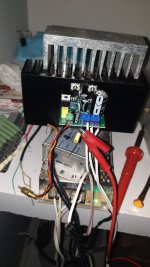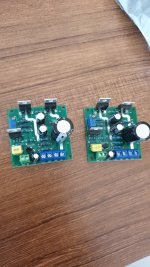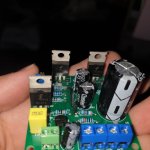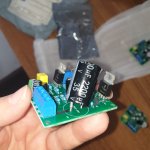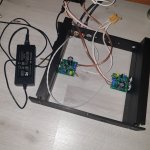Thanks Ian and Vunce for the suggestions, and your point Ian about using a loaded single supply rather than mono PSU's.
Veysel, about the filters: You could check the labels and look up the products (or similar ones) and details online. The idea with these is to block all incoming and outgoing noise at the system's entry/exit point so you may need more than one type or you could already have something like that in place if you are in say, a modern apartment. I've never seen one installed in home audio gear but plenty of PCs and mainframe computers, periferals etc have or had similar type filters integral with their power socket but they were only meant to work in one direction to prevent outgoing noise from contaminating the local power ring and line. Audio gear seldom has problems with emitting EMI but I guess if it uses switched-mode supplies, you may want to add another filter after the power inlet and before the SMPS. Make sure you get input and output right - they probably only work correctly in one direction.
Hi. I have received Cheap Chinese jlh boards (1.5usd each plus tax plus shipping) today and tried with 12v with smps(adjusted to 14v and 1.5a bias ). I am surprised with the result. It sounds loud and good. Left transistor gets about 20C hotter than right one. I also bought another boards which have genuine transistors but this one also sounds good with all fake tip41c and 2sa1015 🙂
Attachments
Yes, I listened to that one or a very similar little JLH amplifier and I was impressed too. It is electrically the same as an original type but uses small, very cheap power transistors. It is OK for headphones and many little desktop speakers but if you want to drive typical hi-fi speakers and make the most of the sound quality, you need at least a rated 5W of power output with 4 Ohms compatibility.
The circuit is similar to the original but you'll need a better driver transistor (TR3 on the JLH schematic) than TIP41. BD139 may not be the best replacement but it's cheap and available everywhere, otherwise 2SD669A (or maybe the smaller 2SD667A) will work better again but check their different pin connections against a datasheet and with your meter. 2SA1015 will be fine for TR4. You do have a small heatsink attached but I would look for something that is thicker, and will conduct heat fast, in order to keep the power transistors as cool as possible. 1.5A bias may not be necessary with a 14V supply anyway, unless your speakers are less than 4R and you push the amplifier to clipping on peak output levels.
The circuit is similar to the original but you'll need a better driver transistor (TR3 on the JLH schematic) than TIP41. BD139 may not be the best replacement but it's cheap and available everywhere, otherwise 2SD669A (or maybe the smaller 2SD667A) will work better again but check their different pin connections against a datasheet and with your meter. 2SA1015 will be fine for TR4. You do have a small heatsink attached but I would look for something that is thicker, and will conduct heat fast, in order to keep the power transistors as cool as possible. 1.5A bias may not be necessary with a 14V supply anyway, unless your speakers are less than 4R and you push the amplifier to clipping on peak output levels.
I found old to220 mica insulators in my storehouse. I forgot to add thermal paste. Should I add thermal paste on and under the mica? Or is it better to buy new to220 silicone insulators?
The different materials of the micas also have different influence on the sound. Thickness too.I found old to220 mica insulators in my storehouse. I forgot to add thermal paste. Should I add thermal paste on and under the mica? Or is it better to buy new to220 silicone insulators?
In the meantime, I no longer use pastes. Even with fat Classe A I have no problems. Rather bigger and better heat sink.
In my opinion, Mica & thermal paste better than the silicone option. Old ones probably better quality than new.I found old to220 mica insulators in my storehouse. I forgot to add thermal paste. Should I add thermal paste on and under the mica? Or is it better to buy new to220 silicone insulators?
Mica washers changing the sound??? Are you nuts? Which sound better, steel or brass mounting screws? Does black PCBs sound better than green or red? I think it is time to get off this thread.
I think Mr Cumbb trying to kidding me. I did not ask about sound quality ,i just asked for thermal transfer optionsMica washers changing the sound??? Are you nuts? Which sound better, steel or brass mounting screws? Does black PCBs sound better than green or red? I think it is time to get off this thread.
I just finished stereo and connected to Topping 20v 3A adapter for trying. Sound is amazing. I am surprised how 5w sounds such high volume.( I think I also just played 2w) Amplifier is very sensitive and there is some buzz on speakers but sound is very dynamic. I will make transformer version and with big heatsinks. Thank you all for your helps and suggestions.
Attachments
Most often, steel screws sound better, because they sonically counter the sound of wooden speaker cabinets and uncoupled drivers.Mica washers changing the sound??? Are you nuts? Which sound better, steel or brass mounting screws? Does black PCBs sound better than green or red? I think it is time to get off this thread.
No circuit boards sound better than black, green or red ones: do it with cables. More precisely: an analog circuit in home audio that requires a circuit board is too complex to sound good: too many components that modulate the sound. You already know that;-)
You did ask about sound quality;-)I think Mr Cumbb trying to kidding me. I did not ask about sound quality ,i just asked for thermal transfer options
Otherwise you would not want to build a JLH;-)
How much of that sound quality is real, audible and verified by others here at the forum (for example) and how much is imagined, personally? Much meaning is lost in translation but I suspect you are speaking only from your own experience, perception or imagination.
Mica is a good thermal insulator actually but because it can easily be sliced very thin, the insulation is less important to the heat transfer quality but any air gaps ruin that heat transfer. Thermal transfer paste containing a high percentage of powdered alumina or similar, restores most of the possible heat transfer quality by filling any voids. If you operate a JLH amplifier at the recommended current and voltage limits for 10-15W audio, you will need the paste or you'll be replacing those transistors more often than you can afford.
The silicone rubber pads also contain alumina type filler but they are necessarily thicker and not so good at heat transfer. Those pads are still very useful for monster class AB amplifiers amps that seldom see more than 5-10% of their output capability used anyway.
Mica is a good thermal insulator actually but because it can easily be sliced very thin, the insulation is less important to the heat transfer quality but any air gaps ruin that heat transfer. Thermal transfer paste containing a high percentage of powdered alumina or similar, restores most of the possible heat transfer quality by filling any voids. If you operate a JLH amplifier at the recommended current and voltage limits for 10-15W audio, you will need the paste or you'll be replacing those transistors more often than you can afford.
The silicone rubber pads also contain alumina type filler but they are necessarily thicker and not so good at heat transfer. Those pads are still very useful for monster class AB amplifiers amps that seldom see more than 5-10% of their output capability used anyway.
Last edited:
- Home
- Amplifiers
- Solid State
- JLH 10 Watt class A amplifier
